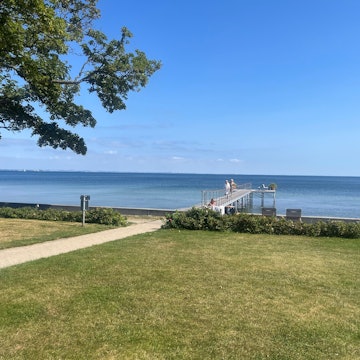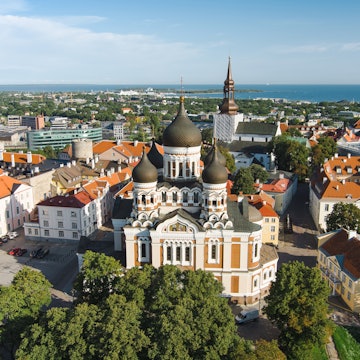

Cyclists riding along a rural road on the island of Ven © Oliver Foerstner / Shutterstock
The fifth-largest country in Europe, Sweden stretches nearly 977 miles (1,572km) from north to south. Fortunately, the public transportation system is excellent, with a mix of trains, long-distance buses and ferries to help you explore.
In more remote regions, options are fewer, but you can still travel between cities and towns without a car, and even get to many national parks and other wilderness areas by public transportation. If you prefer to drive, you’ll find a well-maintained network of highways and secondary roads criss-crossing the country. Here’s a guide to what you need to know about getting around Sweden.
Catching trains in Sweden is easy
Sweden’s extensive train network spans the length and breadth of the country, with approximately 1,500 departures from more than 400 stations nationwide. The state-owned railway company, SJ, operates trains throughout much of the country and serves as a vendor for most regional rail companies, so you can book just about all your tickets on a single website. Most long-distance trains have a bistro car, and you can even pre-order meals if you purchase your train ticket at least 24 hours in advance. For overnight trains, you can book a seat or a bed in a private or shared sleeping compartment.
The easiest ways to purchase tickets are online or through the SJ mobile app, after which you can either print them out, download a PDF to your mobile device, or pick them up at an SJ ticket machine. If none of these options work for you, you can also pick them up for a fee at an SJ service center or at a Pressbyrån or 7 Eleven store. Travelers who are under the age of 26, students or senior citizens are eligible to purchase last-minute tickets at reduced rates.

Long-distance buses are cheaper
Long-distance coach service between cities in Sweden is generally slower than traveling by train, but it’s also usually significantly cheaper. Unlike long-distance train travel, there’s no centralized operator, so you may have to shop around. Flixbus and Vy are the two main companies serving destinations throughout Sweden, but regional bus networks such as Västtrafik, Skånetrafiken and Länstrafiken Norrbotten also cover quite large areas, connecting cities, towns and rural areas.
Planes fly to airports in all corners of Sweden
Trains will generally get you where you need to go in Sweden efficiently and more comfortably than flying, especially if you factor in wait times at the airport and travel to get there, but if you’re short on time, flying may make sense for longer distances. SAS and BRA are the major carriers for domestic flights within Sweden, serving airports in all corners of the country. SAS is based at Arlanda International Airport north of Stockholm, while BRA uses the smaller Bromma Airport in the city as its hub. Air Leap is a smaller carrier that flies between Bromma and Visby on the island of Gotland, and from Arlanda to Halmstad and Örnsköldsvik.

Enjoy the freedom of car travel in Sweden
Although you can easily get around much of Sweden without a car, driving does offer flexibility and the ability to stop and explore whenever the urge grabs you. If you decide to drive, you’ll find major car rental companies at the airports and at least a few different options in most cities. The cost of a rental starts at around SEK 750 (US$85) per day or SEK 1,300 (US$147) per week for a small car with unlimited mileage. A collision damage waiver and theft protection are included, but if you want to eliminate the deductible you’ll need to get supplementary insurance, which can run in the vicinity of 200 SEK (US$23) per day. Gasoline is also pricey in Sweden, especially compared to countries like the United States.
Additional rental fees may apply for drivers under the age of 25 or over age 70. If you’re renting at airports or certain other locations in and near Stockholm or Göteborg, be aware that some companies charge a flat daily fee to cover city congestion fees, while others add the actual charges you’ve accumulated onto your final bill. Wherever you drive, keep an eye out for signs warning of speed cameras ahead. They’re not always on, but if you blow through one too fast, you might get a nasty surprise later on.
Ferries are part of the Sweden travel experience
A long, indented coastline and thousands of islands make ferries an essential part of getting around Sweden. Passenger ferries connect communities in the various archipelagos with the mainland and with each other. Waxholmsbolaget operates to destinations around the Stockholm archipelago, while Västtrafik links communities along the west coast.
Huge, cruise ship-style ferries with car decks connect the large island of Gotland with the mainland ports of Oskarshamn and Nynäshamn. All along the coast and in the larger lakes, smaller ferries connect roads on various islands to the mainland. Most road ferries are free of charge; exceptions are the ferry from Gränna to Visingsö in Lake Vättern and the ferry between Slagsta/Fittja and Ekerö in Lake Mälaren, for which tickets must be purchased before driving aboard.

Public transportation in cities
Swedish cities typically have excellent bus networks that extend well into the suburbs or surrounding countryside. In Stockholm County, buses, subways, commuter trains, streetcars and city-center passenger ferries operate seamlessly under a unified ticket system. Additional passenger ferries connect downtown with communities in the archipelago.
In Göteborg, streetcars and buses wind through the city’s neighborhoods, part of a larger network that extends throughout Västra Götaland County and also includes commuter trains and passenger ferries. In the far south, Skånetrafiken serves Sweden’s third-largest city, Malmö, and the rest of Skåne County.
Sweden is made for bicycle travel
With beautiful rural roads, plentiful urban bike paths and numerous organized long-distance cycling routes, Sweden is made for exploration on two wheels. Rent a bike for a day to explore a city and its environs, or set off on a longer journey to see more of the country at a relaxed pace. RentBike is one option for single- and multi-day bike rentals in southern Sweden and beyond.
You might also like:
Sweden's most stunning national parks: from Lapland to lowlands
Escape to Skåne for food foraging and outdoor recreation
Do I need a visa to visit Sweden?
















